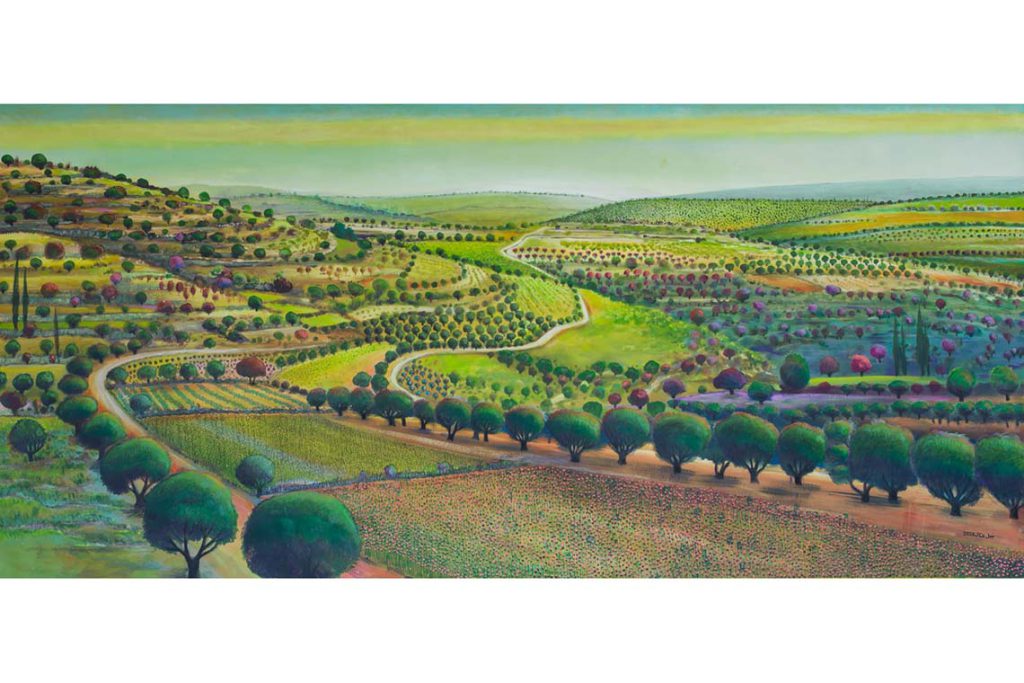More than 25 Palestinian artists, some only recently evacuated from Gaza, come together in Art of Palestine | from the river to the sea, an exhibition at London’s P21 Gallery on living through the unimaginable.
Over and over, Palestinians have articulated the inarticulable. They have reported and photographed and televised the war, even in languages other than their own, even as the machine of occupation consumes them. We have looked at them and we have looked away. Is it the watching from afar which renders us cowardly and small, baulking at realities so unliveable we want to consign them to fiction? Yet there are those who continue to live through this horror, and die from it. And there are those, even when afar, who do not baulk, and continue to advance the cause for Palestinian freedom and endurance.
The Palestine Museum US is the first museum in the Americas dedicated to researching, preserving, sharing and showcasing Palestinian history, heritage and culture. Founded in 2018 by Palestinian American businessman Faisal Saleh, it is located in Woodbridge, Connecticut and produces educational programmes alongside exhibitions, both in the US and abroad. Currently, it is hosting its second exhibition project with P21 Gallery, a charity space in London that promotes Arab culture and creativity.

In the centre of the exhibition’s ground-floor space, like an intimidatingly mammoth Persian rug, is a map of Palestine. Symbols for refugee camps, obliterated and depopulated villages, Jewish colonies and lines drawn by foreign powers litter the cartography, like tattoos of historical progression. It is not an installation; one could technically walk across it. Yet each visitor steps around it with reverence. Here is a map of something real, but which is systematically being made into fiction. Its existence in the show’s centre becomes essential and sacred with this knowledge. An arresting video playing on the wall behind documents the lives of the people, particularly the children, who embody every one of the map’s everyday invisible fluctuations.
Curated by Saleh himself, Art of Palestine | from the river to the sea is as unambiguous and clear-eyed in its approach as its title. Works by more than 25 Palestinian artists, including Mohammed Alhaj, Samia Halaby and Maisara Baroud and covering a wide range of media, crack open aspects of Palestinian life – and death – that so many are determined to invalidate and ignore. The show’s collective focus, pointed as a needle, is to assert the cultural legacy, beauty and resilience of Palestine and its people, particularly through its flourishing art and artists.

One unforgettable work is Ibrahim Alazza’s installation All That Remains (2020–21). Bundles wrapped in keffiyehs dangle from barbed wire hanging down from the ceiling, alongside traditional thobes. The absence in this piece is what is most brutal. In place of bodies, there are only their packed things and garments – their ‘remains’. The thobes are echoed in a nearby painting by Haya Kaabneh, The Mourning of Spring (2024), in which two women sit in a field. The scene is technically pastoral, replete with flora, fauna, fruits and birds – yet all the colours are dark and heavy.
Still, joy too is as crucial to this show as pain. One area, in collaboration with The Palestinian History Tapestry project, displays traditional tatreez works embroidered by Palestinian women. These beautiful, meticulous textile pieces depict the exuberance of their daily lives – their clothing, landscape and architecture, as well as the structures producing their oppression. One work shows Gaza on Fire and another is titled A refugee camp, a military watchtower, and apartheid wall.
Another area spotlights community, particularly in terms of Palestinian youth. A series entitled Children’s Drawings – Operation Cast Lead 2008/9 (2009) shows drawings made as part of a therapy programme for traumatised children in Gaza, following a previous attack by Israel called Operation Cast Lead, which killed approximately 1400 Palestinians, including 300 children. The drawings are inherently playful and unfettered expressions of imagination, yet their contents, stark and violent, render one speechless. There is no pastoral scene to model in these childhoods. The visibility of their traumatisation is a blunt force.

The ground floor of the exhibition packs in a number of additional works. They are a tiny bit cramped, but each one’s clarity of message and form is so lucid that it does not matter. A photograph by Rania Matar of a woman enjoying the sea faces a large, abstract Samia Halaby painting which looks like the insides of a fire and is titled Venetian Red (2021). The final standout is a stomach-twisting digital animation by Nisreen Zahda called Nakba Animated Map (2020) . It is fascinating what modern technologies can produce: the tools to enact an occupation, even from a distance, to change and erase a map, recalculating Palestinian lives and land. As well as the tools to create a digital animation that catalogues, names and presents every single depopulated or destroyed city and village during the 1948 Nakba on a chronological timeline.
Before exiting, one can revisit the very first work in the exhibition: a large landscape by Nabil Anani. Trees, fields, roads and sky stretch out, untouched and pristine. It is the only work here that is easy on the eye. In Pursuit of Utopia #7 (2020) reminds us to consider the challenge of where we place our gazes, whether between fiction and reality, real and unreal, dystopia and utopia, joy and pain. The Palestinian people will not change how they look at themselves. Yet the way we look at them can.
Art of Palestine | from the river to the sea runs until 21 December



